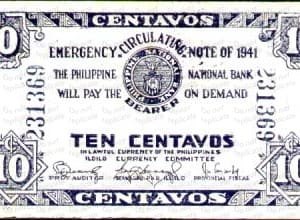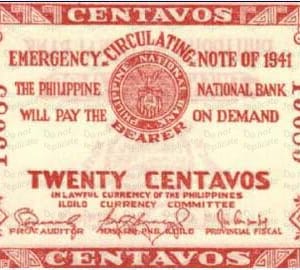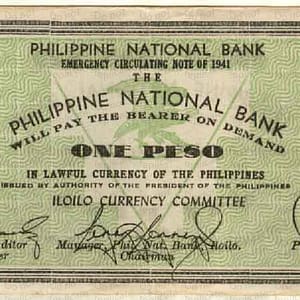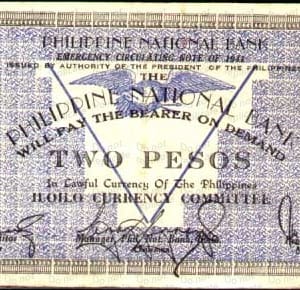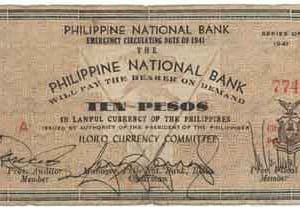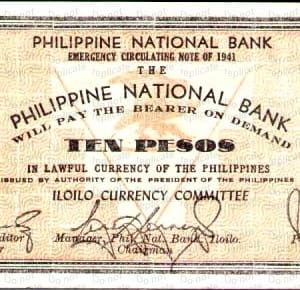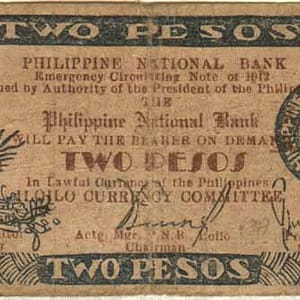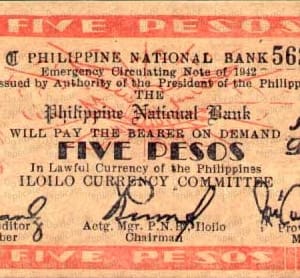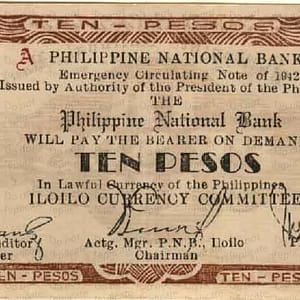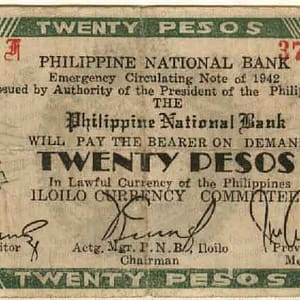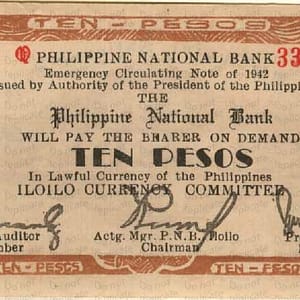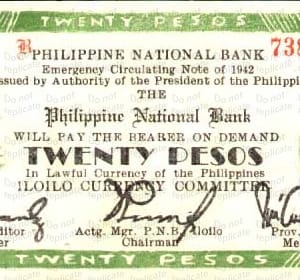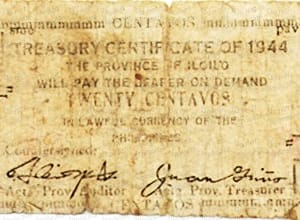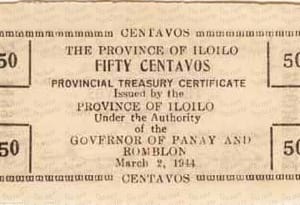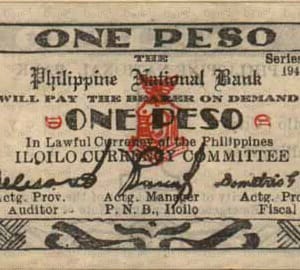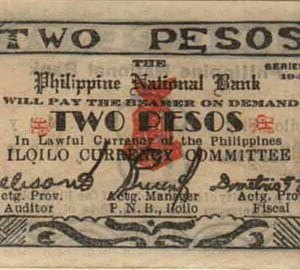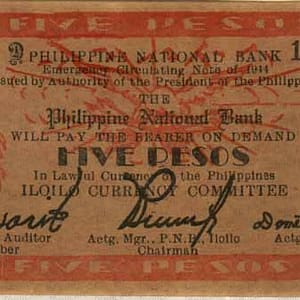Iloilo is the largest province on Panay, occupying the southeast part of the island and also including the nearby island of Gulmaras. President Quezon set up temporary headquarters in Iloilo early in 1942.
Notes were issued from 1941 to 1944 by the Philippine National Bank, and each series was fairly complete. Printing quality is uniformly good for just about all Iloilo notes.
*As an (unrelated) side note: Iloilo is the sister city to my city (Stockton, California). Just thought that was an interesting piece of trivia.
Municipal notes:
- <em>There are no known municipal issues by this province.</em>
Provincial notes:
- Iloilo pre-surrender
President Quezon issued a telegram on December 29th, 1941 authorizing a Currency Committee to be formed. Cenon S. Cervantes was Chairman, Bartolome Fernandez and Jose Quisumbing were members. They were authorized to print 100,000 Pesos in small notes (1 Peso or less) to help with small change shortages.
The committee, after determining that there was a shortage of larger denomination notes as well, decided to print notes ranging from 5 centavos to 10 Pesos. The hired La Defensa Press in Iloilo City to do the printing.
Of the 10 Pesos notes, the first 10,000 were all hand-signed. After this, the signatures were printed.
Once the entire 100,000 Pesos was printed, the Committee attempted to obtain authorization from President Quezon to raise the amount to 3 Million Pesos. They did not receive a reply, but went ahead and printed that many anyway. La Editorial Press in Bilibagan was commissioned to print 2 and 5 Pesos notes at the same time that the other notes were being printed.
Once President Quezon arrived in Panay he changed the amount they were authorized to issue up to 5 Million Pesos, and then on March 14th, 1942 he issued another telegram saying they were authorized to print all the currency needed by the Army in Panay.
When Japan invaded Iloilo on April 16th, 1942, a total of just over 6.5 Million Pesos had been printed.
This series was highly counterfeited during the war. The easiest way to spot one is the serial number was poorly done on almost all counterfeit notes.
POST-SURRENDER NOTES
When the Japanese arrived in Iloilo, the USAFFE and provincial government were well prepared, but General Wainwright still surrendered unconditionally. Lt. Col. Macario Peralta refused the order to surrender, as did a large number of USAFFE members. Col. Peralta immediately started organizing a guerrilla force, and requested that Governor Tomas Confessor take control of the civilian government of the area (including free portions of Antique and Capiz). A proclamation issued on August 13th, 1942 authorized this. Afterwards, Romblon was added, making the Government of Free Panay and Romblon. Col. Peralta also gathered the guerrilla forces on the other Visayan Islands into what he called the IV Philippine Corps.
At a conference on November 15th, 1942, Bartolome Fernandez pointed out that President Quezon authorized the Committee “to print all the currency needed by the Army in Panay“, and this was taken as sufficient authority to print more notes. Cenon S. Cervantes had been captured by the Japanese prior to this point, so his assistant Manager Juan Buenate was appointed to replace him on the Second Iloilo Currency Committee.
Two printing sites were set up far from each other, one in Dialosa to print currency for the Army, and one in Villalon to print currency for the civilian Government. Dialosa used new designs and Villalon reused the plates from the pre-surrender printing.
- First Dialosa printing
Col. Peralta radioed Gen MacArthur in December of 1942, and in a reply dated January 13th, 1943 MacArthur authorized Peralta to “issue a resonable amount of military script“. MacArthur never did another authorization like this. President Quezon backed up this authorization.
On February 28th, 1943 the Dialosa press was shut down.
- Second Dialosa printing
On October 17th, 1943 Dialosa resumed printing for the army. A 100 Pesos denomination was added at this point. These notes were still dated 1942, and bore the signatures of both Fernandez and Quisumbing despite both having already surrendered to the Japanese.
- Villalon (1942)
Villalon was to print currency for the civilian Government, reusing the plates from the pre-surrender printing.
There are no scans of notes from the 1942 Villalon issue.
- Villalon (1943)
After the Dialosa press had shut down, the Villalon press began to be unable to keep up with the demands of both the civilian Government and the military. Peralta sent a unit of guerrillas to demand more money, but the Deputy Governor (Juan Grino) dismantled the press instead, telling Peralta to “come and get it”. While it was being moved, the Japanese captured the printing press.
- Treasury issue (1944)
- “Emergency” issue (1944)


